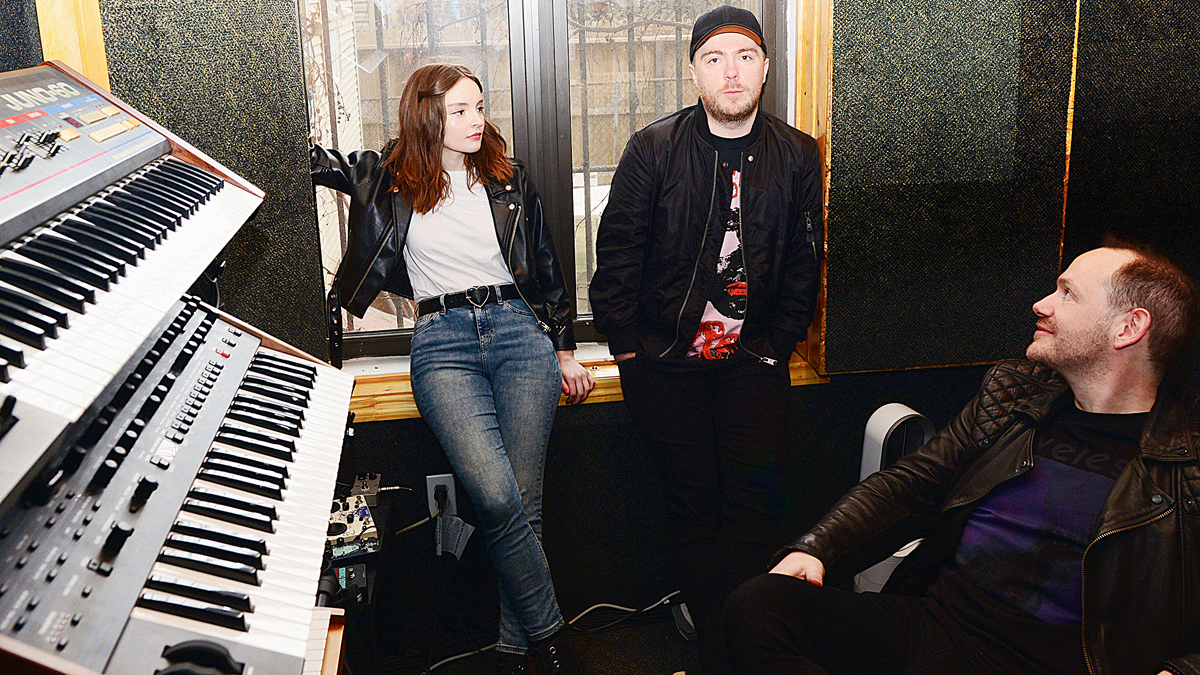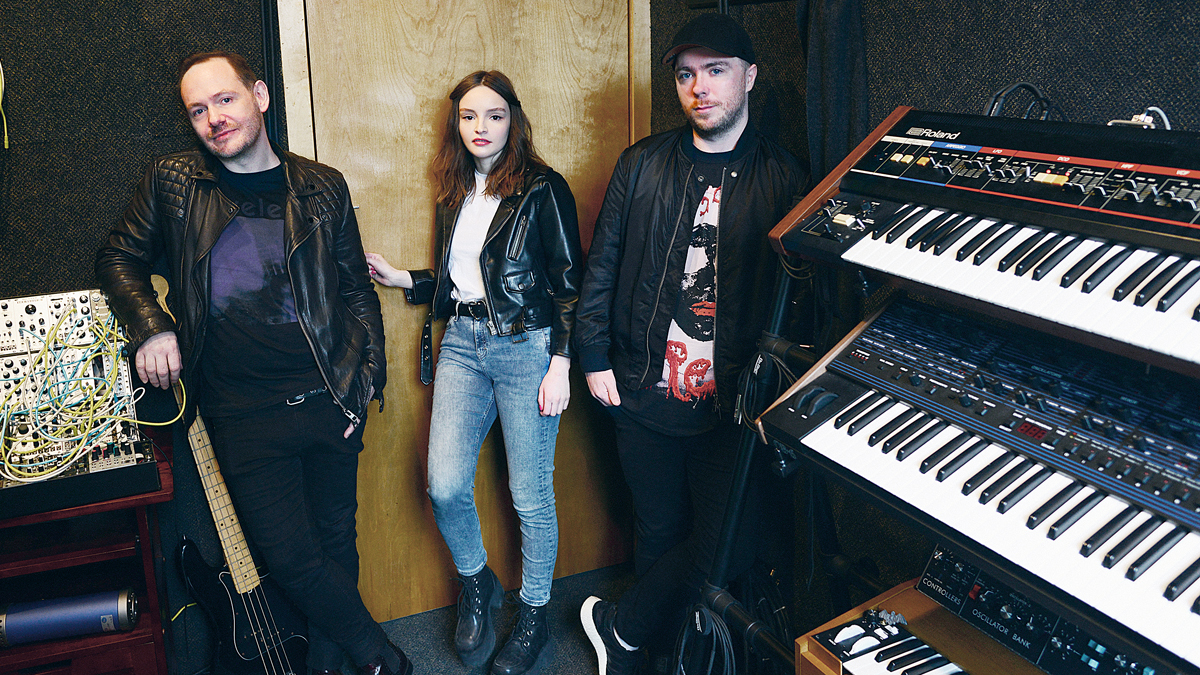Chvrches: “Anything that sounds a bit broken usually piques our interest”
The Glaswegian band on collaboration and why they don’t consider themselves part of the electro-pop world

Combining catchy hooks and interlocking rhythms whose DNA can be found in the mid-’80s stadium rock aesthetic, Glaswegian band Chvrches have created their own modern-day electro pop edifice.
Comprising Lauren Mayberry, Iain Cook and Martin Doherty, their debut album The Bones of What You Believe brought immediate global success, and was surpassed two years later by the cleaner, yet more explosive, Every Open Eye.
With their popularity now cemented, and having historically produced all of their music themselves, the trio faced the age-old risk of whether to change tack or opt for stability. Contemplating collaboration for the first time, the band sought out some of the industry’s finest pop writers and producers, including Eurythmics’ Dave Stewart and Adele co-writer Greg Kurstin...
You teamed up with producer Greg Kurstin for this album. What did he add that you thought was missing or could be improved on?
Iain: “I don’t really think there was anything missing. We’d made two records on our own and felt we had to do that to consolidate our sound, identity and vision as artists and producers. From that point of confidence and assurance, we were able to say, ‘why not broaden the picture and see what it’s like?’ If none of the collaborations worked, fine, but we’re glad to say that a couple of them were very fruitful and Greg’s input was the most fruitful from day one.”
Martin: “Greg is renowned as one of the finest producers at the moment and was one of the first names that came up. I actually went to visit him and came back raving about it. This guy’s studio is not what you’d expect from a fancy LA producer; it’s alive with the sound of synthesizers, each one plugged into every guitar pedal you can imagine. The workflow was like nothing I’d ever seen before, and I had thought Greg would be a good collaborator because we came from a very similar place in terms of how we physically create the music. David Stewart was another name that came up really early, and of course we jumped at the chance of that as well.”
We understand Dave was almost like a mentor in some respects…
Get the MusicRadar Newsletter
Want all the hottest music and gear news, reviews, deals, features and more, direct to your inbox? Sign up here.
Iain: “He’s the Mr Miyagi of music [laughs]. Dave is one of the most incredibly artistic minds I’ve ever had the pleasure to meet, let alone work with. He had a sense of perspective for Chvrches that I don’t think we could even see, especially from Lauren’s point of view. We did two sessions, and from the first day he could see what we were trying to achieve and was very inspiring.
Dave Stewart is the Mr Miyagi of music
“We did five songs, none of which made the record, but I’m sure a couple of them will surface because we’re very proud of what we did with him. Dave was totally instrumental in setting the tone and helping us explore how we could further the story of the band.”
Because you’ve always been successful doing things your way, it would be easy to think your decisions are always the right ones…
Martin: “I genuinely don’t feel like we relinquished any control in this process. We found baseline collaborators who were able to fuse to our dynamic and augment what we do. When you have an opinion in the room like Dave’s, who’s sold 100 million albums, that’s an invaluable resource, and there was no ego or hierarchy.
“It was the same with Steve Mac who also knew when to muck in or pull back and respect our identity - these guys are smart enough to realise that this is not a band that needs to be reformed within an inch of its life.”
Iain: “Greg has an incredible sense of melody in his keyboard playing. He’s a jazz-trained pianist, so when he was jamming synth lines, the melodies that were built into his parts were just flowing every time he got behind a keyboard. It was like the way Johnny Marr played guitar in the Smiths’ heyday when they were at their most melodic with hits like This Charming Man. Greg was the keyboard equivalent of that, which really inspired us.”

Was Greg involved in the mixing process?
Martin: “He was happy to hand that over to Spike Stent, as we both were. We’re two albums in with Spike and there’s something about what he does that makes our records leap out of the speakers at people.”
Iain: “Spike brings so much to the table that the album was almost ready to go after mixing. The mastering was the last five percent to tidy things up and pull things into line. On the first record, we were planning to mix our own stuff, but it’s really good to have another pair of ears, especially when you’re as close to everything as we are. At that point, it really doesn’t make a lot of sense to mix it, as long as you’ve got your house in order.”
Was moving to New York another aspect of this desire for new surroundings or a change of environment that would inform the music?
Martin: “I wish that when we moved to New York we’d had some sort of glamorous surroundings. All we did was move our equipment from one industrial estate to another, which was just like our place in Glasgow but a quarter of the size. But I found it to be a very creative time, especially the first six months of writing. A lot of it was about fact finding and experimentation, deciding what sort of album we were out to make before we really jumped into it.”
What did you bring over from Scotland for those initial recording sessions?
Iain: “A few synths - the Juno-106, Moog Voyager and Dave Smith’s Oberheim OB6 and Prophet-6. We also brought loads of outboard, like preamps, EQs, the interface and monitor controllers.”
Martin: “Everything except the Jupiter-8, because we put the Jupiter on every single song on the second album. I was obsessed with it, so every time we were writing I would gravitate towards it. Weirdly, from it being a cornerstone of that album, we didn’t use it at all this time, although it really is the Rolls-Royce of vintage synthesizers.”
Iain: “The one thing that really found its place at the heart of the record was the Minimoog Model D. We had a Moog Voyager kicking around and always knew the real deal was much sought after but could never find one. Greg had a really old ’70s one, and compared to the Voyager it’s so raucous, angry sounding and big. It’s on almost every song on the record, and we ended up getting the new Model D reissue and fell in love with that too.”
We get the impression that the drums on the album are programmed in?
Martin: “There’s definitely a lot of treatment on the drums, but there are actually a lot of full-on live takes in there as well. They’re chopped up and blended with electronics for the most part, which I guess is why it sounds disguised.
“Most of the songs have a live drum track at the core and then we built around it with electronics. Greg’s a big fan of using electronic reverb tails and did all sorts of weird experimentation, but we wanted to bring the live aspect more into focus this time.”
Are Lauren’s lyrics written after the music is recorded or integrated into the process?
Martin: “That’s been an interesting change on this record. Historically, Iain and I would work up to the point where we’d create a nonsense melodic and phonetic landscape without words and Lauren would go away and write to that, but this time Lauren was in the room throughout a lot of the jamming process. We always tried to get a vocal hook before the end of the day, and it made for a more successful result.”
There seems to be a paradox between Lauren’s dark lyrics and what are still fairly bright and poppy songs…
Iain: “I think that’s something that we’ve always considered to be a trademark of the band; that tension between bright sounds in the music and dark lyrics. There are points where we’ve flipped that and gone darker and weirder, but it’s a line that we’ve always tried to tread quite carefully.”
The sounds you use are quite attacking aren’t they? Is there anything you favour using for those types of sounds?
Martin: “Attacking sounds is quite a good way to describe it; we’re always out to dial in on the aggression we’ve grown to enjoy throughout our lives coming from a post-rock/alternative rock background originally. We’ve always been interested in keyboards, but I’ve never felt particularly connected to the electro-pop world. The rough edges are always important to us, so we use aggressive bass synth and wide, heavily chorused noises - anything that sounds a bit broken usually piques our interest.”
It sounds more mid-’80s than early-’80s, when pop was full of power ballads with aggressive drums and chunky, angular rhythms…
Martin: “Without question I think that’s a big part of our DNA. Going back to Dave Stewart, that original session was like going to the source of something that had been an inspiration to us for so much time. The Eurythmics were using artistic, non-standard ways to make mainstream music - they were more like a stadium band than an electronic band, yet the driving force behind that was a guitar player.”
How do you both work together on the arrangements? Do you both have distinctive yet complementary roles?
Martin: “Iain is very technically minded and considered, and obviously very creative. He has an unbelievable depth of knowledge on production and all-round musicianship. My role tends to be more focused on spontaneous melodic creation.”
Iain: “I think Martin is selling himself a little bit short in terms of how his technical attention to detail comes into play towards the end of the process. He’s very exact about how things should be in his head, and I’m pretty good at helping him realise that. So there is a lot of crossover, but we also complement each other’s skill set, so I think it’s a pretty unique creative relationship.”
Martin: “Not to put ourselves in that echelon, but a lot of the great production duos have a healthy dynamic where you can challenge and excite each other. I write a lot of stuff alone and think it’s really cool, but it doesn’t feel like it’s on the level of what we do together because there’s something Iain brings that takes what I do to a place it could never go alone. We’re also able to work incredibly quickly on things.”
Do you try to avoid complicating the production and do you feel pop music has more of an instant impact when it’s less layered?
Iain: “That’s something that we always strive to do. Our natural instinct is to layer and complicate things, but because we work so intensely we have a tendency to lose perspective. Now we’re getting a lot better at stripping it back, but you’re absolutely right to say that having a concise and distilled version of your sound is the hardest thing to do.”

What’s the most important aspect that you try to nail?
Iain: “The rhythmic components of a melody are paramount to us. The way that a melody attacks certain words and phrases and interplays with the kick drum and snare; that interlocking, rhythmic component is everything in pop music. Often when we build up a track, the melody will take a slight shift rhythmically and we’ll have to rebuild the entire rhythm track because the way those things complement each other is how a pop song works.”
Martin: “My advice is to listen to hours and hours of Michael Jackson and learn from the master. When you listen to someone who does rhythm on that level - something like Smooth Criminal, I don’t think it can be bettered. The moving parts are so deeply considered, musical and technical, but appear on the surface to be as simple as it gets. We’ve always drawn inspiration from that, but it’s well-documented that there’s no Michael Jackson without Quincy Jones. Jackson was a genius, but he had a collaborator who was able to elevate him to a level I don’t think anyone has touched since.”
My advice is to listen to hours and hours of Michael Jackson and learn from the master
The music’s quite in your face... What techniques do you employ to keep the volume down to acceptable levels?
Martin: “That’s a big conversation with us and there’s no denying it’s a very fine line. One of the great battles of the modern recording sphere is the concept of loudness and distortion. I’m happy to push it to the edge, because I achieve some sort of subconscious excitement from that, but that’s not to say there’s no value in the kind of headroom there was on records from the past.”
Iain: “I tend to like music that has more headroom, and if you need it to be louder turn it up. At the same time I do understand that it’s an aesthetic thing and it’s perfectly acceptable for certain types of music to be more bombastic. For us it’s a compromise; we’re looking for something that sounds really big without crushing it too far or taking it to a point where it starts to sound ugly. Spike does the mixing, so I’m not sure what compressors and limiters he uses. When we’re tracking, we do have some outboard gear, but hooking it up slows down the workflow at times so we end up taking the software route, which is 90% based on UAD.”
What DAW are you using these days?
Iain: “We used to use Cubase a lot, but got fed up with the bugs, so we ended up giving Pro Tools a try and recorded a bunch of demos. That changed the workflow in interesting ways because it’s incredibly quick at certain things, but towards the end we gravitated towards Logic because Greg uses Logic and we wanted the sessions to talk to each other in a meaningful way.”
Martin: “Although 99% of the time we used Greg’s hardware, we’re big fans of the Arturia V Collection. I’m a fan of augmenting hardware synths with software plugins - it’s a big part of what we do. We’re also obsessed with Psychic Modulation’s EchoMelt plugin - it’s like a delay and chorus all-in-one and instantaneously turns anything into a rich and warm yet darker, rougher-sounding entity. It works wonderfully on keyboards right across the board.”
Iain: “EchoMelt does what you would imagine an old, fucked VHS tape would do when it has that weird tape snag and blurry chorus feel. Once you put it on stuff, you can’t go back. Otherwise, we’re big fans of Soundtoys’ Little AlterBoy as a quick-fix creative tool for doing really mad pitchshifting. EchoBoy is really good, too, and FabFilter, whose compressors and EQs are good.”
Martin: “Valhalla Shimmer and Vintage Verb are also cornerstones of our sound, along with UAD’s AMS RMX 16 reverb plugin, which is awesome. I could talk all day about the UAD stuff; it’s across everything we do - both in the studio and on our personal rigs.”
Chvrches’ new album Love Is Dead is out now on Glassnote Records. Head on over to the Chvrches website for more.
Future Music is the number one magazine for today's producers. Packed with technique and technology we'll help you make great new music. All-access artist interviews, in-depth gear reviews, essential production tutorials and much more. Every marvellous monthly edition features reliable reviews of the latest and greatest hardware and software technology and techniques, unparalleled advice, in-depth interviews, sensational free samples and so much more to improve the experience and outcome of your music-making.
“I called out to Mutt and said, ‘How about this?’... It was a complete fluke": How Def Leppard created a rock anthem - with a little bit of divine intervention
"It was ugly, like watching a divorce between four people. After a while, I had to get out": Beatles engineer Geoff Emerick on the recording of Abbey Road, track-by-track










